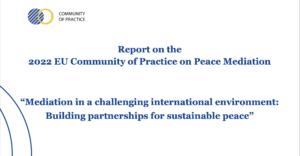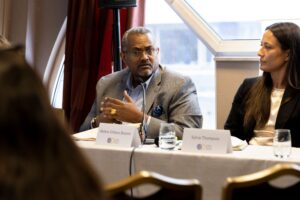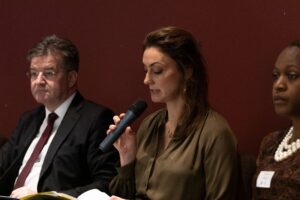The 2022 EU Community of Practice on Peace Mediation – What is Next? Meeting Conclusions and Recommendations

A comprehensive report summarising the rich discussions that took place during the 2022 EU Community of Practice (CoP) on Peace Mediation in Brussels on 26-27 October has now been published, with a set of targeted and concrete recommendations for the way ahead. CMI – Martti Ahtisaari Peace Foundation had the pleasure of contributing to these discussions.

Simon Bojsen-Moller, Deputy Head, Crisis Response, Conflict Prevention and Peacebuilding Unit, Foreign Policy Instruments, European Commission, Ville Brummer, Chief Programme Officer of CMI – Martti Ahtisaari Peace Foundation, Hiba Qasas, Director Principles for Peace Secretariat, Interpeace, at the 2022 EU Community of Practice on Peace Mediation in Brussels. Photo: Maria Santto / CMI.
Multiple high-level panels and talks took place at the 2022 EU CoP on Peace Mediation in Brussels last October. The EU Community of Practice for Mediation engaged with a wide range of civil society actors and policy-makers from around the world, providing concrete recommendations on how to further build partnerships for sustainable peace in an increasingly challenging international environment. The newly published report on the discussions confirms that CoP has a unique ability to help the EU in adapting mediation efforts to current and future realities and in providing information and data, especially in spaces where the EU is less present. Discussions on the complexity of engaging with all actors is a recurring theme, with examples of how digital tools and online platforms, as well as the media can help bring groups together, engage with new actors or specific groups and ensure access to information.
The report also showcases how mediation is a tool that stretches beyond peace negotiations, and should be mainstreamed across all conflict related concepts, including transnational justice, elections and ceasefire. Important insights are shared about the psychological aspects of trust building as well as how to address linkages between social cohesion and trauma. Recommendations are made for how to improve EU support for mediation by more accessible funds and grants, also to local actors, and better linked short- and long-term investments.

Abdeta Dribssa Beyenne (PhD), Executive Director of the Centre for Dialogue, Research and Cooperation (CDRC) in Addis Ababa, Ethiopia and Sylvia Thompson, Senior Manager of Sub-Saharan Africa Team at CMI. Photo: Maria Santto / CMI.

Miroslav Lajčák, EU Special Representative for the Belgrade-Pristina Dialogue and Western Balkan Regional Issues, Benedikta von Seherr-Thoss, Managing Director, CSDP and Crisis Response from the European External Action Service and Fatima Maiga, Founding Member and President, Coalition des Femmes Leaders Nord, Sud et Centre du Mali speaking during discussions on peace mediation. Photo: Maria Santto / CMI.
The report concludes that the EU continues to play an important role in conflict resolution around the globe; a role that can be further strengthened by enhanced coordination mechanisms to ensure complementarity between layers and levels of mediation and the actors involved. Inclusivity and building strategic partnerships with civil society, local mediators and insider mediators stand out as key for achieving more sustainable solutions.
Soon, the preparations will start for the fifth edition of the EU CoP on Peace Mediation, and information will be published on the website once available. In the meantime, see below for a more comprehensive summary of the recommendations made, or read the full report here.
Main Recommendations 2022 EU Community of Practice on Peace Mediation
Revised mediation tools and approaches:
- Shift the focus from reaching peace agreements (quick fixes) to building sustainable peace, exploring also informal dialogue options and partial agreements.
- Better linkage of mediation with processes that present other key building blocks for sustainable peace (and vice versa, cross-fertilising), including:
- Transitional justice, to generate ideas, strategies and resources, and include transitional justice advisors in mediation.
- Elections, by encouraging the integration of mediation tools and initiatives at different levels of an election process, for example to address polarising hate speech.
- Ceasefires, to better integrate these within broader peace processes, engaging peace actors (in particular local ones) from the outset, creating efficient monitoring mechanisms and ensuring sustainable funding and peace dividends.
- Natural resource management, to prevent intra- and inter-community conflicts exacerbated by climate change, in particular between herders and farmers.
Partnerships:
- Strengthen existing and building new strategic partnerships – horizontal and vertical – across institutions, structures and organisations, enhancing complementarity and synergies. Ensure efficient coordination between partners, to prevent ‘forum shopping’.
- Support regular dialogue and exchange platforms, including between women mediator networks that can support each other across the continents.
- Consider making the EU Community of Practice a permanent forum for exchange and learning.
- Continue strong EU support to the UN’s mediation efforts on the ground and at HQ level.
- Create and nurture partnerships between the peace mediation community and humanitarian and development actors.
Inclusivity:
- Engage with youth movements to ensure they become agents for peace and are included in decision-making processes. Use technology and online tools and provide technical and advocacy support/awareness-raising.
- Strengthen the role of women in peace processes, shifting from a supply to demand driven approach proactively raising the profile of women, for example by co-mediation. Make Women, Peace and Security a truly political agenda. Draw upon women meditator networks as a strategic tool. Support partnerships between women mediator networks and key actors and leaders.
- Review funding mechanisms to ensure that they support inclusivity more strategically, with a particular focus on women and youth.
- Explore ways to engage more with non-state and informal actors, including with armed (including extremist) groups when necessary and relevant. This requires enhanced situational awareness and local knowledge, flexibility and adaptability, and cultural sensitivity.
Connected and supported local and regional mediation:
- Provide technical and logistical support to protect and connect insider mediators across conflicts and regions.
- Strengthen connections between informal and insider mediation, and formal negotiation and peace processes – connecting the dots between mediation tracks through a coordination mechanism across different levels (local, regional and international) and layers (formal and informal).
- Trust in local solutions and investing in community level mediation actors and activities in a pragmatic manner.
An integrated approach for sustainable peace:
- Make better use of the CSDP missions and operations to support dialogue and play a preventive role. This might require mandates that are more flexible and a closer alignment with other EU instruments and priorities.
- Better linkage of short- and long-term actions to ensure that funding cycles reflect long-term needs of mediation efforts, their broad scope and need for flexibility. Complement mediation with shuttle diplomacy in between mediation opportunities.
New mediation tools and approaches:
- Ensure capacity building on psychology and trauma sensitive approaches for mediation, and on the link between social cohesion and trauma, enhancing mediators’ ability to build trust, as well as cope with the task at hand.
- Draw on digital peace-making tools to advance / influence peace processes and ensure broader inclusion and engaging with new actors and specific groups. This requires increased capacity building, including on security aspects, and further integration of digital aspects into mediation practices and guidelines.
- Make better use of media to enhance inclusivity and broader buy-in of peace processes, and improve strategic communication, in particular on mediation in practice (including story telling). Map media actors and conduct joint trainings for mediators and journalists on different mediation aspects.
The CoP 2022 was organised by the EEAS Mediation Support Team (ISP.2.) together with Particip and CMI within the framework contract on Conflict Prevention and Mediation implemented by the Particip Consortium. The event was supported by a Steering Committee including CMI, Conciliation Resources/EU Mediateur, European Peacebuilding Liaison Office (EPLO), European Institute of Peace (EIP), ERMES III – European Resources for Mediation Support (ERMES), and Particip.